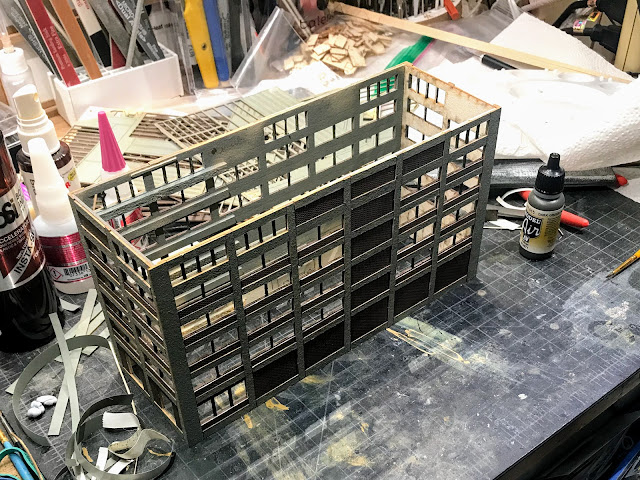 |
Karl Gebele's Kompakt-Anlagen ('Compact Layouts')
book. Cynical North American modelers probably
notice the unweathered rolling stock and roller coaster
curves and grades first, but miss Karl's genius: pure
wonder and romance, expressed in virtuoso scenery
as well as artfully rendered slices of German life. Like
it or not, Karl's work is more achievable, connects
with the public better and will inspire more partici-
pation in the hobby than basements filled with fleets
of era-specific rolling stock and stylized operations.
|
My venture into overseas model railroading is yielding new insights into not only new models and modeling techniques, but also into alternative approaches to and philosophies of model railroading.
Or put another way, I'm learning that the ideal of model railroading as put forth in the major US model rail magazines ain't the only way to do model railroading.
Tom Barbalet of the Model Rail Radio podcast and others have pointed out the elements of the 'orthodoxy' of the US model railroad industrial complex: fixation on a few major US prototype railroads; idealization of recent past railroad eras; large lifetime layouts with expansive fleets of locos and rolling stock; virtuoso prototype- and period- specific rolling stock modeling; idealization of advanced over simpler functional techniques (i.e. disdain for sectional track in favor of difficult handlaid or flex track); DCC, sound, and state-of-the-art electronics, including signaling and detection; and finally its apotheosis in complex, formal operations sessions. A look through the big magazines and the offerings of the major US model rail manufacturers strongly support Tom's 'orthodoxy' thesis.
Tom and others have also pointed out that there are alternatives to the large lifetime layout, such as modules and smaller layouts. A look through European model railroading magazines, books, and videos (check out
Pilentum TV on YouTube) further reveals that superdetailed, era-specific prototype modeling is not the only satisfying end-goal of model railroading. Indeed, there's a strong case to be made that an alternative end-goal for the hobby is communicating with the public and capturing the imaginations of non-model railroaders.
Karl Gebele is a fixture of the German model railroading press, and his new book,
Kompakt-Anlagen: Viel Modellbahn auf wenig Raum ("Compact Layouts: Much Model Railroading in Little Space"; available in North America from Amazon Germany) showcases such an accessible and imaginative approach to model railroading. A quick Google search will turn up numerous photos and videos of Karl's work, which demonstrates that excellent model railroading can--and does--routinely take place on tiny layouts with sharp-curved sectional track with ready-to-run rolling stock equipped with pizza cutter flanges and oversized couplers.
The genius of Karl's work is that he visualizes and models contemporary German life and culture, leaning heavily into excellent scenery, painting, and finishing techniques. For non-model railroading Germans, and for anyone who is familiar with Germany from travel or military service, Karl's vignettes and visual idioms are instantly recognizable. For example, the opening photograph of the book depicts--unmistakably--Germany's wine country.
What North American modelers could take away from Karl's work--and what the North American Model Railroad Industrial Complex should be championing--is how to work with the limitations of space and resources to do inspiring modeling that tells stories and engages non-model railroaders. In particular, Karl shows how to work with small radius curves, steep grades, and sectional track--without ending up looking cartoonish or whimsical. The major magazines occasionally showcase excellent small layouts that forthrightly incorporate sharp curves and grades while evoking a place and time, but such coverage is rare enough to be remarkable. Rick Van Laar's CSX layout, featured in the February 2011
Model Railroader (also available
here in a compilation of 4x8 layout stories) is one of those layouts, and so is
Steve Campbell's HiTop layout, which was also featured in MR in March 2016.
Europeans do have it easier, in one particular way, with their small layouts: most of their model rolling stick, regardless of scale, is engineered to run on much tighter curves than North American equipment. This is partly a function of smaller prototype equipment--the largest European electric or diesel is roughly the size of an Amtrak ACS-64 or AEM-7, there are virtually no large articulated steam locos, and few freight cars are longer than 40'. But it's also a function of market expectations. European manufacturers want to make their wares usable by as many model railroaders as possible. This approach is democratizing, in its way, because anyone can run virtually any car or locomotive, regardless of layout size. One of the qualities I have always admired about my MTH HO South Shore Little Joe is its 18" minimum radius--would that I could have had this locomotive on my first HO layout, built of course with sectional track back in the 70s. Instead, the brass models of that period were not only expensive, they ran poorly and required impossibly broad curves.
My own takeaway from Karl's book and from the European approach to model railroading is a validation of how I plan to move ahead with my own hobby. A basement empire is not in my future, but modules and small layouts are. And I particularly enjoy modeling that results in a 'wow' not from other model railroaders, but from lay non model railroaders. When my sister, who thinks model railroading is silly, immediately recognized Dune Acres (AKA Mineral Springs Road) on my Dunes Junction layout, I knew I had been successful. Same when my wife noticed that the different parts of the Old Line Corridor actually correspond to various sections of the actual Northeast Corridor. "That looks like Jersey, but this other part looks like Maryland between BWI and Union Station." She also thinks my tiny trains are ridiculous, but I managed to connect them to her world.
And connections--like the ones that Karl Gebele makes--are what I want from my model railroading.





